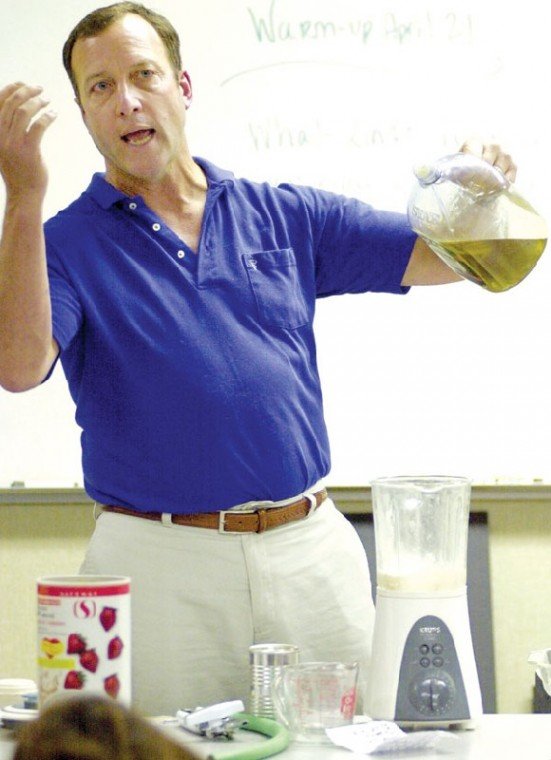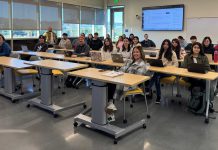Dissecting an animal organ
– say, a cow’s heart or eyeball – is a classic rite of passage
for high school students.
But cutting into those organs is just the tip of the iceberg for
Gilroy High School students in the veterinary science program, new
this year.
Dissecting an animal organ – say, a cow’s heart or eyeball – is a classic rite of passage for high school students.
But cutting into those organs is just the tip of the iceberg for Gilroy High School students in the veterinary science program, new this year.
Also on the syllabus: spaying and neutering household pets, dissecting a frog and cat, performing animal ultrasounds and learning recipes for wet and dry dog food. Besides learning the ins and outs of animal nutrition, diseases, anatomy and physiology, the students observe Greg Martinez, of Gilroy Veterinary Hospital, perform a multitude of real world procedures right in the classroom.
“It was awesome, you got to see all the parts of the body that you never get to see,” said Christen Scherck, after watching Martinez dissect animals on more than one occasion.
During Martinez’ most recent lecture – he comes about once every two weeks – he whipped up some dog food to teach the students about canine nutrition. He is a vital part of GHS’ vet science course, the first of its kind at the school.
“(The class is) a good way of getting started, for those who want to get into something involving animals,” said Ashley Kaufman, a senior who wants to work with endangered species.
“I learned how to castrate something – I can put that on my résumé, I know,” quipped Scherck, a junior.
Still, what she’s learned of vet science should prove useful in the future: Scherck plans to be a veterinarian.
Agriculture teachers Rachel Kelly and Heather Nolan started the vet science course this year.
“I saw a need for it,” Kelly said. “Students who are in the ag program have to choose between the ag program and college-prep classes. We implemented this program so students can still enroll in ag and get (college) credit.”
Vet science, a vocational education course, is currently the only such course to offer college preparatory credit.
Interestingly, Kelly said, the majority of her students are not in the agriculture program, which still tells her she is filling a need. When recruiting students last year, Kelly expected to get enough to fill up one class. Instead, she said, 50 signed up, filling two class sections.
“So the initial thought was to get the college prep credits for the ag students, (but) I would say the majority of my students are non-ag students who want to get into animal sciences,” Kelly said.
Junior Trillian Hamilton said her love of four-legged friends became a passion years ago. She plans to work as an animal behaviorist.
“Basically, you go into a home and if a dog is chewing up all the shoes, you figure out why,” Hamilton said.
Even students with a passing interest in veterinary science would likely enjoy the course, Kelly said. Martinez’s contribution makes all the difference.
“Dr. Martinez has been absolutely superb with the students, and the students love him,” she said. “He’s volunteered a lot of his time and a lot of materials for the course.”
“He cracks jokes all the time,” said Jenna Ortolan, a junior.
Martinez also accompanies the students on field trips. They visited the Monterey Bay Aquarium and soon will get a behind-the-scenes glimpse of the San Francisco Zoo. Martinez’s business partner, Dennis Harrigan, also has lectured to the students.
To enroll in the course, students must have passed agricultural science, plant and animal science or have the recommendation of a counselor or teacher.
The typical vocational classes, like woodshop and auto mechanics, are geared more toward students who will enter those fields and involve much more physical labor.
“A lot of my kids in here don’t necessarily want to do that – not that there’s anything wrong with it – but this is a good way to get that credit with more of a science focus,” Kelly said.
Kelly seems to enjoy teaching the class just as much as the students enjoy attending it. Unfortunately, she won’t be able to continue with the class next year because she is moving to another city.
“I’m really sad because I’m leaving and I’m just getting things started,” she said.
Nolan will continue teaching the vet science classes next year.
“We plan on it, it’s really in demand,” Kelly said.















